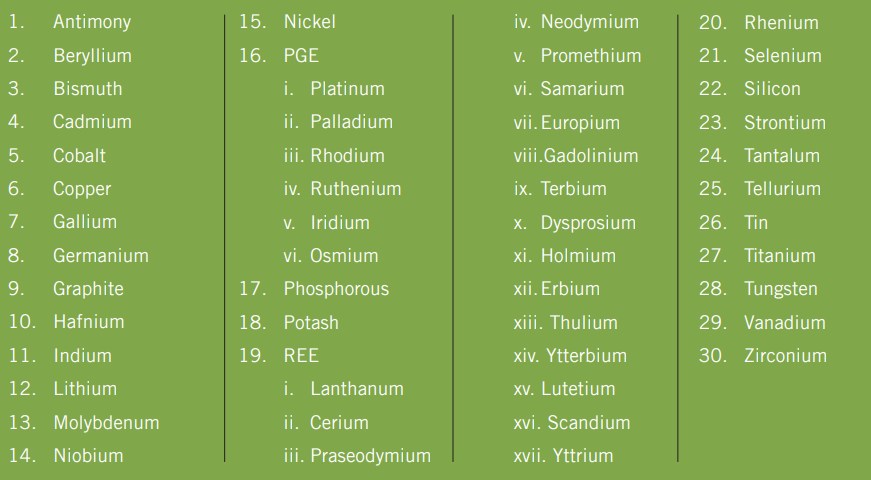Table of Contents
Critical Minerals
Context: India and the U.S. aim to quickly conclude a bilateral agreement to enhance cooperation on critical minerals.
More in News
- Key Focus Areas: Developing a partnership in supply chains for minerals such as graphite, gallium, and germanium.
- Promoting India’s vital role in the mineral security partnership.
- Strategic Initiatives:
- Co-investing in lithium resource projects in South America.
- Exploring rare earth deposits in Africa for sustainable and diversified mineral supply chains.
- Framework: This cooperation is part of the India-U.S. Initiative for Critical and Emerging Technology (iCET) dialogue, led by the National Security Advisers of both countries.
- Recent Developments:
- In July 2023, India released a list of 30 critical minerals.
- India is acquiring mines abroad to secure critical mineral supplies and expanding domestic exploration.
- Legislation: The Mines and Minerals (Development and Regulation) Act, 1957, was amended through the MMDR Amendment Act, 2023, to facilitate this initiative.
- Corporate Involvement: India incorporated a joint venture company, Khanij Bidesh India Ltd. (KABIL), with equity contributions from National Aluminium Company Ltd, Hindustan Copper Ltd, and Mineral Exploration and Consultancy Ltd.
- KABIL’s objective is to acquire critical mineral assets abroad for consistent supply to India’s domestic market.
- KABIL is exploring opportunities for acquiring lithium and cobalt assets in Australia, Argentina, and Chile.
What are Critical Minerals?
- Critical minerals are mineral resources, both primary and processed, that are essential inputs in modern technologies, economies, and national security.
- They are characterised by the risk of supply chain disruption due to non-availability and price volatility.
- These minerals play a crucial role in various industries and sectors and have limited substitutes, making them of strategic importance.
- Elements included: It includes metallic and non-metallic elements such as Antimony, Beryllium, Cobalt, Germanium, Graphite, Indium, Lithium, Niobium, 17 Rare earths (heavy and light), Rhenium, Tantalum, Silicon, Strontium, Vanadium, Zirconium etc.

- Significance:
- They are critical as their associated impact on the economy is relatively higher than the other raw materials and they have limited substitutes.
- Utility Across Industries: Beyond decarbonization, critical minerals are essential for manufacturing fertilizers, construction materials, industrial magnets, consumer electronics, and defence equipment.
- Solar PV plants, wind farms, and electric vehicles all require significantly more minerals than fossil fuel-based systems.
- Demand for Clean Energy Technologies: The IEA has estimated that to achieve the Paris Agreement targets, over 40% of copper and rare earth, 60-70% of nickel and cobalt, and 90% of lithium demand will be for clean energy technologies by 2040.
- Clean energy technology mineral demand is projected to quadruple by 2040 to meet climate goals.
- Global Concentration:
- Geographical Distribution: Australia controls 55% of the world’s lithium reserves, China possesses 60% of rare earths, the Democratic Republic of Congo (DRC) commands 75% of cobalt production, Indonesia has 35% of nickel, and Chile owns 30% of copper reserves.
- China’s Market Influence: China monopolises the processing of 35% of the world’s nickel, 50-70% of lithium and cobalt, and nearly 90% of rare earth elements.
- Chinese companies actively invest in mining resources globally, further extending their influence on the supply of critical minerals.
- Response to China’s Dominance:
- Formation of Mineral Security Partnership (MSP): The MSP includes nations such as Australia, Canada, Sweden, Norway, Japan, and South Korea, combining resources and processing technologies to counter China’s monopoly.
- MSP’s strategy of “friend shoring” aims to move manufacturing from China to allied countries.
- Formation of Mineral Security Partnership (MSP): The MSP includes nations such as Australia, Canada, Sweden, Norway, Japan, and South Korea, combining resources and processing technologies to counter China’s monopoly.
| Related Information |
|
Indian Cities – Heat Traps
Context: Indian cities have become “heat traps” due to their unbalanced growth devouring water bodies and increasing greenhouse emissions.
What are Heat Waves?
- Heat waves are extreme events in which hot temperatures in summer months persist for a relatively long period of time.
- Criterion for declaring a heatwave in India (as per IMD):
|
Details about HeatWave |
|
| Heatwave is considered if the maximum temperature of a station reaches at least 40°C or more for Plains and at least 30°C or more for Hilly regions. | |
| Based on Departure from Normal | Based on Actual Maximum Temperature |
|
|
| Note: If the above criteria are met at least 2 stations in a Meteorological subdivision for at least two consecutive days, then the heatwave will be declared on the second day. | |
| Criteria for describing a heatwave in coastal stations: When maximum temperature departure is 4.5°C or more from normal, Heat waves may be described provided the actual maximum temperature is 37°C or more. | |
Delhi Temperature Data:
- The highest daily temperatures in Delhi have remained above 40 degrees Celsius since May, expected to fall below this mark only by the end of June.
- Recently, Delhi recorded about 44 degrees Celsius, with a perceived temperature of 49.2 degrees Celsius.
What are the Contributing Factors for Turning CIties into Heat Traps?
- Climate Change: Climate change has led to a rise in global temperatures, exacerbating heatwaves. This results in higher average temperatures and more intense heat waves, which are now longer and more frequent.
- Additionally, it affects the diurnal temperature range, reducing the drop in temperatures at night. This results in nights that are almost as hot as the days, increasing the overall heat stress on residents.
- Urban Growth: Unbalanced urban development reducing wetlands and water bodies, along with increased greenhouse gas emissions, have contributed to cities becoming heat traps.
- Permeable Spaces: The reduction of permeable spaces in urban areas exacerbates heat retention, making nights nearly as uncomfortable as days.
Suggestions
- Heat Action Plans: Implementing heat action plans that include providing drinking water, better medical facilities, rescheduling outdoor work, and adjusting school vacations.
- However there have been financial struggles of cities to implement heat action plans, stating that they lack additional budgets.
- Long-Term Strategies:
- Building Insulation: Increasing heat insulation of buildings.
- Shelters: Developing shelters for urban poor and slum dwellers.
- Water Bodies: Investing in cooling water bodies.
Examples, Case Studies and Data
- Air Pollution (GS 3): According to the Environmental Performance Index (EPI) for 2024, India ranked 176th out of 180 countries with 27.6 points, placing above only Pakistan, Vietnam, Laos, and Myanmar.
- It performs poorly in air quality, emissions, and biodiversity conservation, primarily due to its heavy reliance on coal, which significantly contributes to greenhouse gas emissions and air pollution levels.
- It was released by The Yale Center for Environmental Law and Policy and the Columbia Center for International Earth Science Information Network.


 Places in News for UPSC 2025 for Prelims...
Places in News for UPSC 2025 for Prelims...
 New Phase of Operation Chakra to Combat ...
New Phase of Operation Chakra to Combat ...
 Soyuz Aircraft: History, Design and Sign...
Soyuz Aircraft: History, Design and Sign...





















